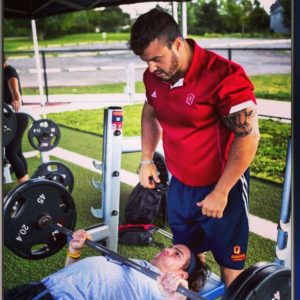
02 Jul 5 Reasons Why You Need To Read 10/20/Life & Give At Least A Few Things A Try
By: Brian Carroll
So, you think 10/20/Life is stupid and gimmicky? Fine but… do you even know what it is? 10 & 20 weeks at a time for a lifetime of positive momentum in training and in life. How is this accomplished? In short, by being more a cerebral lifter than a brute force one.
Use your ability to think critically for a moment and pretend that I didn’t (insert your favorite personality) create this philosophy for a minute and consider using these tips for your strength training even if only a couple of them… even just one of them. There are many great programs around but in my opinion a great deal of the programs leave just enough rope for you to hang yourself with when the lifting times are critical; i.e. peaking for meet, pushing too hard too early or simply never taking some downtime in the offseason or even ever considering a deload. Also, not everyone will need speed work. This is a fact. Some will and this will be determined on a person to person basis as everyone is different. Personally, I will look cool as hell doing it, but if not to dial in my form, it’s useless since I’m already super fast. With this said, take a look at these tips below.
Don’t miss lifts in training due to failure and pushing too hard. This does nothing but beat you down mentally as well as physically, kill your momentum in training (and outside) and also -potentially injure you. This is your body’s way of telling you that you’re training too heavy in almost all cases. Yes, you will have some breakdowns technique wise from time to time that will cause you to miss – this is actually acceptable and this should be the only time you miss in training. Not from going 101% because you needed to ‘see where you are’. This is what the competition is for “to see where you are and where you stack up” not in training every week. We all know the ‘guy’ or ‘gal’ who maxes out every training session, never leaves ANYTHING in the tank and is a ‘show out’ in the gym. He or she loves the attention and always lays an egg in the meet because once again, it’s just another day to go all out and the gas tank is tapped out. I lay out a great offseason and pre-contest that you can ‘base’ (not follow blindly) to keep you from going too heavy too often and build that positive momentum I’m always talking about.
Have a plan and have phases of training. Have down time, i.e. an offseason, as well as different training phases in your plan. Yes, you should have a plan. It cannot be simply full bore 24/7 – trust me I’ve tried this many times over the last 15 years. Every sport has an offseason to not only recover but to work on weak points and to heal up mentally and physically. For instance – my quads in squat transition is what holds my squat back. I will NOT fix this 6 weeks out from a meet! I have to address this with the time necessary and away from a peaking phase to do it correctly as it takes time. This has been what I’ve struggled with since dropping 30lbs as I’ve lost quad size and power and it’s been a process as my leverages have changed. To help build this and combat this weakness – I have been implementing a crap load of piston and goblet squats in the offseason to help combat this and building both quad size and power that I lost in the weight reduction. The bottom line (if you’re not an outlier) if you’re always training for a meet, how much better do you feel you will truly get? Regardless of how close you are to superman, you still will need time to come off, rest, reset and have time to reflect and make the adjustments necessary. This has really helped me have the longevity that many lifters after 4-6 years miss out on and eventually disappear to never to be heard of again.
Have time away from being 100% locked in a powerlifting mind set and allow yourself to do other things you enjoy. I’m not saying to do dumb shit like lifting up someone’s car to show off (won’t mention names; JL Holdsworth) jump into a 5k for the hell of it without any practice or get fat (like I have many times). What I’m saying is have time away that is good for you mentally and physically. This is above and beyond having an offseason program to work on weak points. You need time with your family, friends and something else or hobby(s) to keep you busy. I don’t care how much you love, live and breathe Powerlifting – you can and will get burnt out eventually. And if you somehow don’t, your body will end up betraying you. It’s only a matter of time – burn the candle at both ends and redline it for too long, you will break mentally and or physically! It’s good to have something, even if it’s mindless to take some stress out of your life and break up the monotony. The people that say you don’t need down time or deloads; look at their resume and see their track history. I like many things outside of lifting/coaching. I love writing, fishing, movies and lately, I love to watch Netflix. A favorite these days is “It’s Always Sunny” – it reminds me that I’m not quite as terrible as a person as some! Mindless is good at times.
Work on what you suck at and look no further than 10/20/Life. In 10/20/life I have a self diagnosing weak point index that can help guide you and point you in the right direction for ALL of your assistance work. For example – if you miss in the middle of the deadlift, once your form is 100% locked in and is not an issue, you address the weak points suggested in the index that is holding your deadlift back in the middle range. I have this for you to use for the bottom, middle and bottom of the squat/bench and deadlift. Yes, you get better at the big 3 by doing them but to correct weakness holding you back in the big 3 will require attacking the weakness, not simply doing the lift more often. With that said, the index will not always be 100% exactly what you need BUT it’s a great start and will most definitely point you in the right direction to get you started. It will also teach you to critically think for yourself. There’s no other strength guide like it out there, especially in any of the ‘popular programs’ that you have heard about, tried and read of. If that means I’m once again copied, that’s awesome!
Strengthen & stiffen your core and use a proper warm-up. I advocate a 4 part system that takes all of about 10min:
- Break a sweat.
- Stiffen your core using the McGill big 3.
- Specialized mobility or movement for that particular day. I.e: Squat day, goblet squats for tight hips or something you need to work on for that day.
- Do 20-40 reps with the empty bar i.e. bench day, bench the bar.
The McGill big 3 have been the biggest change (along with moving like an athlete 24/7) that I’ve added to my warm-up and prehab/rehab. They are staples that you can take away from 10/20/Life and my athletes. Moving like an athlete and warming up properly are the 2 biggest things that I preach at my seminars and to anyone whom asks me how to treat their back pain. Once again, if you’re a strength athlete, flexibility is not your friend. Mindless mobility work is not your friend and being more flexible will not lower your chances for being injured. Actually the exact opposite is true for the muscles of the back as they are created to prevent movement. Want a mobile spine? Be ready for one that is more likely hurt. Being able to get into the correct positions safely and pain free is all that you need. Any more will come back to hurt you, eventually through lack of power and/or injury. Having a stiff core (which is a benefit of the 10/20/Life warm-up) and healthy hips/shoulders is key. Shoulders and hips should have good and proper ROM and the core (think trunk/back) should be super stiff. This is how you create power – stiffness, not being Gumby’s little brother or sister.
Brian Carroll
Latest posts by Brian Carroll (see all)
- Brian Carroll Coaches the Birddog - April 24, 2024
- Protected: -Header Image Post Template 2024 - April 18, 2024
- Brian Carroll X Professor Stu McGill full interview 2024 - April 16, 2024





![10599499_10152807886534722_2186879300162025217_n1[1]](https://www.powerrackstrength.com/wp-content/uploads/2014/11/10599499_10152807886534722_2186879300162025217_n11.jpg)

Sorry, the comment form is closed at this time.